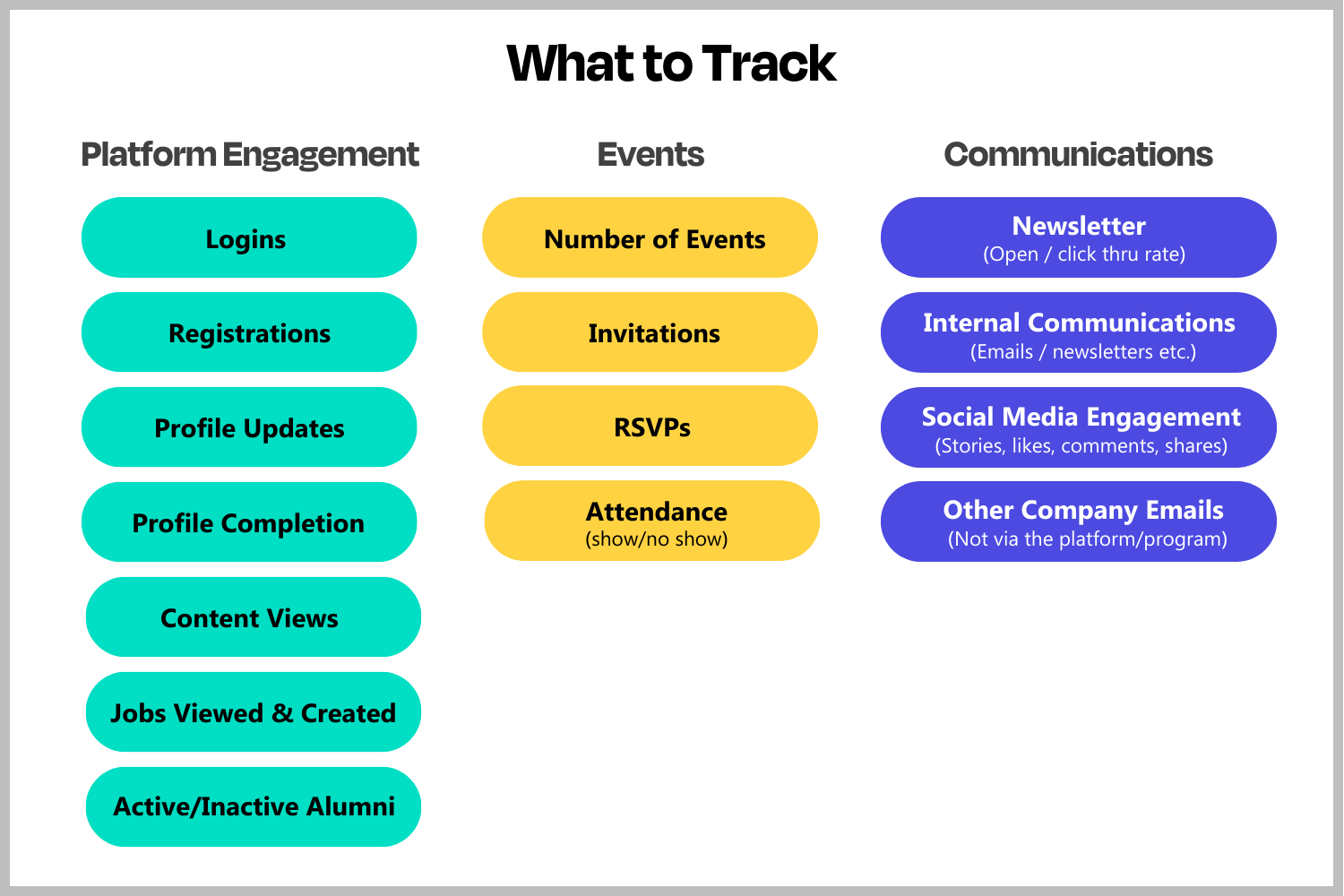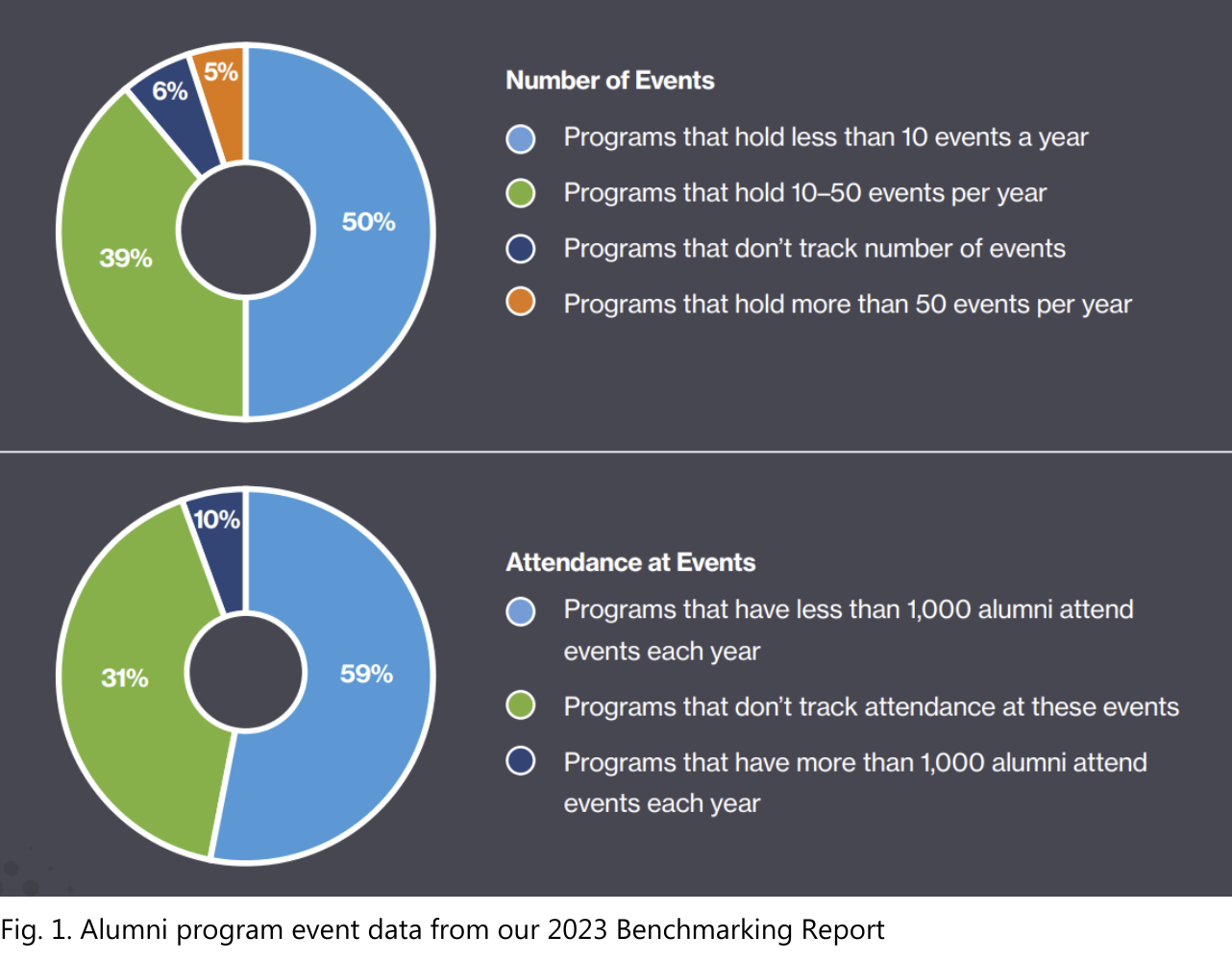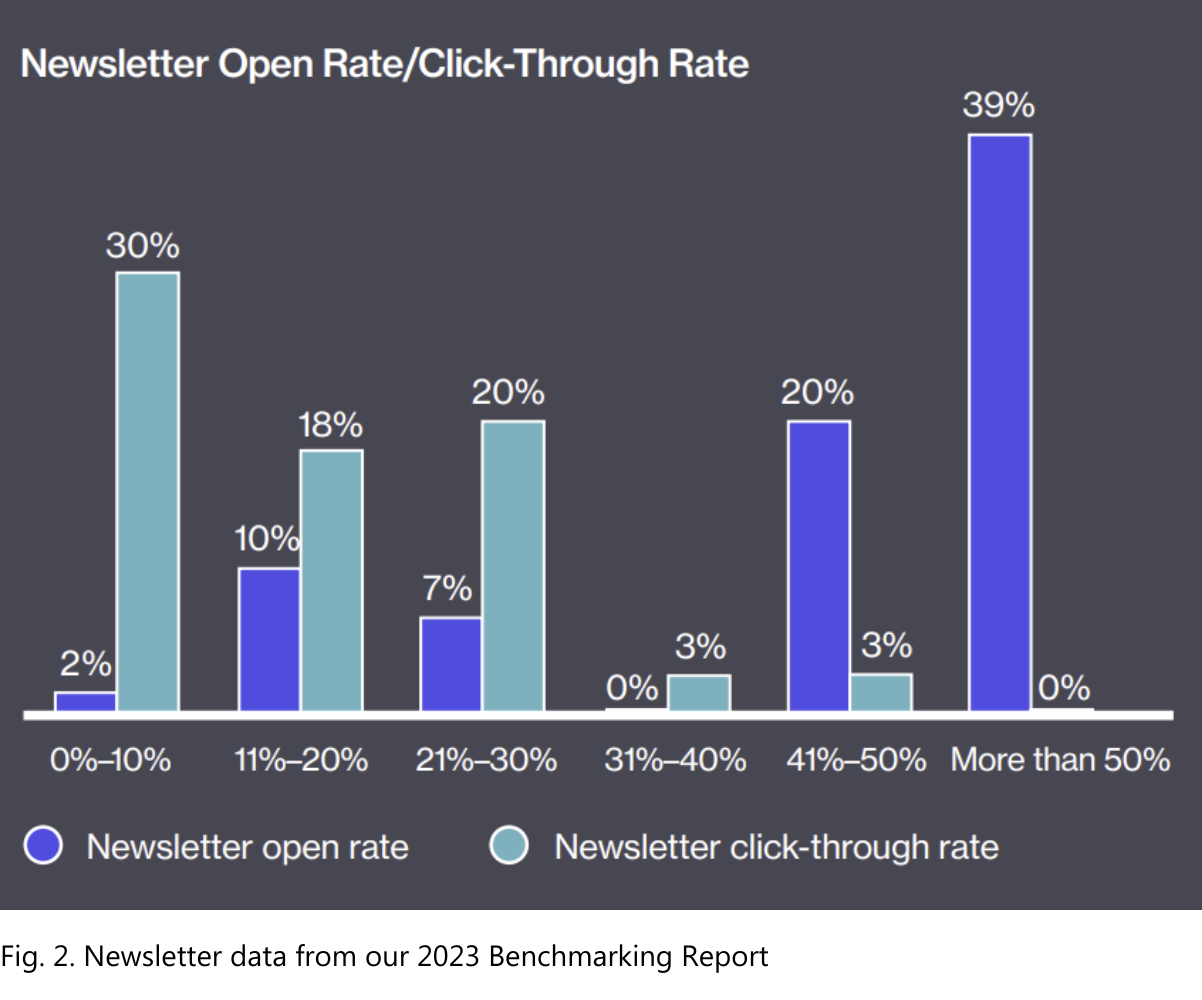Blog
Essential Alumni Engagement Metrics to Track

Consistently reviewing alumni engagement metrics validates a strategy, monitors advancement, and identifies trends in your corporate alumni program, guaranteeing your team's efforts are worthwhile.
If you’re not monitoring alumni engagement metrics, you might be overlooking valuable insights that can considerably influence the success of your alumni program. A properly engaged corporate alumni network holds countless benefits for a business and you want to ensure you’re maximizing your efforts.
According to our most recent 2023 Corporate Alumni Benchmarking Report, there’s variations in tracking practices and a strong potential for improved analytics. For example, we found that 37% of respondents do not track alumni logins, and 49% do not track employee logins. Given the accessibility of reporting technology, featured within the PeoplePath platform, we highly recommend harnessing this valuable data source to your advantage.
In this post, we'll explore the different areas of community health and highlight key alumni engagement metrics crucial for strategic decision-making and program enhancement.
Getting Started: Define What Success Means
Effective tracking and reporting of alumni engagement metrics begins with defining what success looks like to your program and optimizing your technology setup:
- Identify core business goals for your program (align with leadership, if needed). Key outcomes may be related to rehiring, referrals, business expansion, and brand advocacy.
- Ensure the data structure with your platform uses reliable sources and captures all relevant data points.
- Configure program analytics within your platform. Report on user engagement with content and the platform. Develop content and event strategies for support.
Community Health: The Day-to-Day Metrics to Focus On
Day-to-day community health is comprised of platform activity and engagement initiatives. Consistently sharing information and engaging your community on and off the platform will support and strengthen the overall business goals. Building the community over time will lead to an increase in the program goals you set in the beginning. Three areas of engagement to focus on are:
Platform Engagement
- The hub of your alumni community providing relevant and personalized content to encourage member engagement. We found that 70% of companies now have a third-party platform (such as PeoplePath) for better integration across initiatives and to achieve goals (up 11% from 2022).
Events
- Events are the cornerstone of engaging your community members and should happen frequently for connectivity. 39% of companies we surveyed held 10-50 events per year.
Communications
- Communications can and should take place both on and off the platform and include internal communications, marketing opportunities, and social media.

Platform Engagement Metrics
Logins: (employee and alumni): What is the min., avg., and max. numbers in a period of time that members are logging in? When alumni log in to the platform, they are likely to update their profile information, sign up for events, review job postings, and interact with other members.
Registrations: How many new members register in a given period of time? The rate at which new members join the community is indicative of its appeal and strength. Optimize your offboarding process to ensure seamless onboarding into the alumni program and maintain high conversion rates.
Profile Updates: Track profile updates by month, quarter, or year. The data consultancy, Informatica, found that contact data decays by at least 30 percent every year. It’s important that members keep their data up to date to get the most out of the network and may need a nudge from time to time. Reminders can be automated through platform capabilities when members have been inactive for a specified time or combined with an incentivization campaign.
Profile Completion: Having a complete profile is essential for fostering meaningful engagement within your community and ensuring a personalized experience that aligns with their unique needs and qualities. PeoplePath offers an automatic reminder at the top of the feed, encouraging them to update their information and build a dynamic profile.
Active/Non-active Members: Examining the frequency and way members interact with the platform and its offerings, provides a transparent measure of community well-being. In the PeoplePath platform, we compute an “Activity Index” for each member, indicating their frequency of logins, content access, and material viewing. Similarly, a “Contribution Index”, reflects the amount of user-generated content (self-authored articles, or spotlights), postings on forums, commenting, sharing or other social media contributions. This simplifies the identification of active contributors and less engaged members and helps shape tailored strategies.
Leveraging technology enables you to automate campaigns aimed at inactive members, delivering personalized messages and content to motivate alumni to re-engage. Alternatively, you can pinpoint your program's valuable champions and further cultivate them into indispensable assets.
Content Views: Monitoring content views, shares, and likes, including articles and alumni spotlights, reveals which pieces connect best with your audience and shapes your future content planning.
Job Creation and Views: Monitor whether recruiters utilize this channel to promote job openings and assess the attractiveness of the advertised positions by tracking views and number of applications. If your program permits, track the number of jobs and in which organizations that are being posted by alumni to support business development activities.
In certain cases, check if the integrations can facilitate status updates in your ATS regarding alumni applicants and the number of positions eventually filled by alumni. These figures can then be employed to quantify the financial advantages your organizational gains from rehiring alumni. You can find more information on measuring this value in our research.
Events
 The attendance count at community events, whether virtual or in-person, showcases member interest and engagement. Events are a great catalyst for program engagement, encouraging individuals to log in and RSVP, as well as a reminder to keep their contact information up to date.
The attendance count at community events, whether virtual or in-person, showcases member interest and engagement. Events are a great catalyst for program engagement, encouraging individuals to log in and RSVP, as well as a reminder to keep their contact information up to date.
RSVPs: Allows programs to identify which of their members are the most engaged and what they’re most interested in.
Attendance (Shows/no shows): If there was a high no show rate, this could indicate a need to adjust communications leading up to the event. Maybe there's a need to enhance anticipation in the lead-up to the event, send more reminders, or reconsider the timing of the year.
Number of Events: Tracking event numbers helps in allocating resources efficiently. If you see a steady increase in participation, you can plan and budget for more events. Conversely, a decline might lead to resource re-evaluation. Monitoring event frequency helps ensure a diverse range of activities. It prevents repetitive events and keeps alumni engaged with fresh and relevant content.
Communications
Looking at a holistic view of touchpoints on the platform, on social media, and through internal communications in the company aids in understanding if your message is resonating.
Social Media Shares: Tracking the number of times community content is shared, liked, or commented on across social media platforms serves as a testament to engagement and brand advocacy.
 Newsletter open/click-thru rate: Ensure your efforts aren’t going to waste on content that isn’t piquing the interest of the reader. It might come down to a catchier subject line, or more visually appealing layout. Explore different ways to elevate your newsletter format.
Newsletter open/click-thru rate: Ensure your efforts aren’t going to waste on content that isn’t piquing the interest of the reader. It might come down to a catchier subject line, or more visually appealing layout. Explore different ways to elevate your newsletter format.
Other emails/communication not through the platform/program: Ensure that members don't receive excessive communication from multiple sources, and that the information isn't repetitive. If you notice high unsubscribe rates after specific outreaches, you may have to adjust the frequency alumni receive communications and/or the relevancy of the messaging.
We found that 59% of programs that send newsletters receive an open rate of more than 40%. This suggests that content emailed to alumni is highly viewed and read, leading to more logins on the platform or company website traffic. 77% of managers track how many alumni open the newsletter, and 74% measure how many subsequently click through the materials.
Embracing Robust Reporting Tools
Effective engagement measurement enables your team to visually present data, often through charts or tables, while dashboards aggregate metrics and reports into a comprehensive overview. This visual representation aids trend analysis and informed decision-making. Effectively presenting results regularly demonstrates the success and evolution of the program to leadership and maintains the program visibility.
Alumni engagement metrics are more than numbers; they are the compass that guides your program to greatness. So, measure, analyze, and translate these insights onto actionable strategies to support on-going success.


